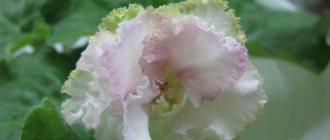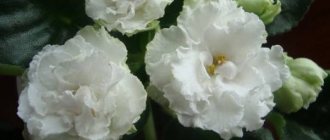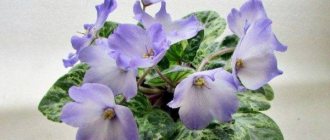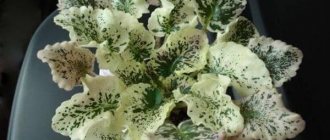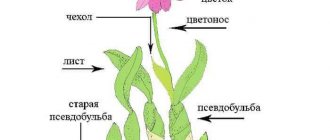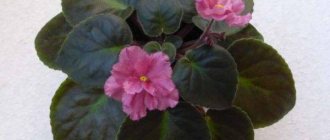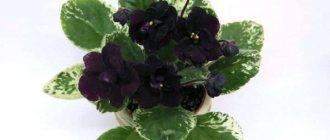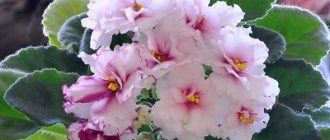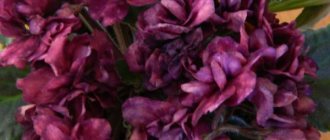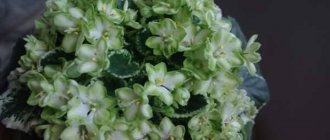The richest flow of colors and model configurations of Saintpaulia varieties registered by foreign breeding masters would be incomplete without retro varieties, which include violets Ruffled Skies and Ruffled Skies 2 (K.Stork/G.Boone).
Thanks to the time-tested sophistication of flowering and the pompous majesty of the images, as well as because of their self-sufficiency during development, both violets can still arouse the genuine interest of gardeners and are worthy of taking the best places on the shelves of collections.
History of the creation of varieties
The described violets, which bring colorful animation to all the orderly rows of collection specimens, were obtained by the promoter of pelargoniums and Usambara violets, an internationally recognized master of breeding art from Iowa, USA, Gordon Boone (G. Boone).
But for registration in the lists of AVSA, the most important organization of American violet growers, the varieties were presented by K. Stork , and therefore have dual authorship (K. Stork / G. Boone).
Gordon's passion for plants began in childhood, when he, helping his father, worked in a small nursery in his hometown.
Boone spent his early years in Canada - it was there that he really became involved in working with flowers, first with pelargoniums and then with violets.
He became involved in the selection of Saintpaulias thanks to his acquaintance with the master of violet breeding, Ernest Fischer , and gradually began to be considered a genius in his field.
At the end of the 70s, G. Boon returned to his homeland, continuing to work on improving the qualities and images of violets. But, unfortunately, flower growers have become acquainted with only a small fraction of them.
Reviews
Marina. “After purchasing a leaf of this variety, I waited a very long time for the result. At first, I maintained the viability of the leaf for a year using wick watering, after which I planted it in the ground. The rooted leaf simply did not give birth, and I threw it away in disappointment. Now I’m looking for a baby to buy, it’s more reliable.”
Oksana Mikheeva. “Having bought a flowering specimen, I was very happy with this purchase, but afterwards I was a little disappointed. Either my care methods are not perfect, or the variety is very demanding.
This variety attracts many gardeners with its color.
It blooms rarely for me, and I can’t get large flowers. Usually semi-double, with inexpressive fringe, and the color does not quite match the original.”
Olga Konstantinovna. “Having purchased a baby of this variety, I am very pleased. Flowering is regular, abundant, double flowers, beautifully colored with fringe. The variety is quite easy to care for, and if you choose the right techniques, it pleases the eye.”
Violet "Ruffled Skies"
This section presents photos and descriptions of the Ruffled Skies violet variety. This magnificently airy variety has become familiar to flower growers since 1992.
Description of the variety
This incredibly delicate vintage beauty is distinguished by its classic format , which varies upward among the most diligent flower growers and reaches the scale of large subspecies.
After independently entering the stage of an adult plant, Saintpaulia is a neat, strictly rationally arranged bush, overflowing with leaves to the compacted texture of a tiled silhouette.
NOTABLE! Over time, the rosette develops a configuration with compact, sharpened silhouette boundaries, but it is possible to create a hemispherical shape by bending the leaf plates to the flowerpot.
The medium-sized leaves in the texture of a broadly constructed oval are distinguished by the volumetric quilting of the textured-dusty layer, well-cut teeth along the edge in the form of relief curves, and a graphically symmetrical pattern of venation.
They also stand out for their attention-grabbing clear structural pattern and bright emerald hue , as well as the dark color of the malachite plates, which sometimes want to take on a wavy configuration or hug a flowerpot.
At first, the budding of the variety . By the third flowering, the violet creates an outstanding volume of frilly caps from large-sized “star” corollas with a terry-textured structure, whose petals are characterized by significant undulation and abundant corrugation of the edges.
The tonal color palette of the corollas of the vintage variety combines the changeable nuances of the bluish-blue spectrum with lilac tints and the white color of rich lace along the frilly contour of the petals .
The boundaries of the edging flow in watercolor into the main tone of the flower, without a clear structure and continuity.
Sports
Violet Rufled Skyes can sport, forming variations:
- with excessively double flowers of darker shades with a green edging fringe - “Ruffled Skies-2” ;
- with a variegated rosette of pink and beige shades;
- with white corollas in a greenish outline and a semi-miniature bush - CM-Mont Plaisir or Saint-Petersburg Sky .
Features of development and flowering
Flower growers the lovely retro-varietal violet for its outstanding decorative effect, the absence of unnecessary hassle due to the plant’s independence and the presence of a minimum of unexpected pitfalls.
Growth in apartment collections
The interest of violet growers in the vintage variety of violets is due to the unpretentiousness of the specimens and modest character. Special touches may be noted:
- the ability to successfully self-form neat forms of rosettes;
- luxuriously tight silhouette configurations;
- the exceptional significance of the flower caps;
- a calm attitude towards the lack of light;
- continuous frequency of flowering.
The complicated strokes of Saintpaulia include:
- lengthening of peduncles under lamp lighting;
- inexpressive first flowering;
- instability of decorative color waves;
- bending leaves to the flowerpot.
Breeding feature
ATTENTION! Problem-free propagation of the variety is ensured by easy pinching and excellent pecking of a mass of well-developing children.
Temperature and flowering
The hot conditions of apartment collections negate the decoration of the corollas in the form of a white border. The decorative appearance of flowers is preserved better in cool conditions.
The variety bears many buds on persistent pedicels of slightly oversized size.
The presented variety is characterized by the creation of magnificent caps from the third round of budding.
The corollas of the vintage violet variety exhibit healthy decorativeness and freshness for more than one and a half months.
Reviews
Galina Ivanovna. “Violet Ruffled Skies is a chic retro variety. It's almost thirty years old and better than many modern options. For so long, I haven’t changed my qualities one iota.”
Features of flowering, growth and reproduction
Taking into account the characteristics of the variety, this flower can be propagated in any available way , maintaining all the parameters. The main ones are:
- Sheets – cut off a viable leaf from the third or fourth row. Rooting is carried out in a convenient way:
Most often, violets are propagated by leaves.- In water - the cutting is placed in water and waits for roots to form, then planted in the ground (sometimes kept in water until the baby forms);
- In the ground - the leaf is planted immediately in the ground, after which a greenhouse is built over it, watered and waiting for the babies to appear;
- In moss - this method is used for wick watering of cuttings. A leaf is placed in moss and placed on wick watering; it is transplanted into the ground after the baby grows up.
- Stepchildren - the stepson is cut off after it has grown to independence, and, if necessary, rooted using one of the methods suitable for sheets;
- Peduncles - cuttings from peduncles are rooted in soil, which is poured in a thin layer, and then covered with glass or film.
The most complex and rarely used method is the seed method . Seeds are used to breed new varieties, and very rarely for propagation of one individual.
The new rosette grows quite quickly, but for this individual the process may take a long time . It usually takes about a year for the plant to mature, and the first flowering of the starter occurs after about 8-12 months.
The peduncles are short , rise low above the leaves, and from two to five buds are formed on each of them. Each bud blooms for a long time, up to two weeks. The characteristics of the variety allow you to get cap flowering, and quite easily, you just need to pinch off the first flower stalks.
Violet “Ruffled Skies 2”
Below you will find a photo and description of the violet Ruffled Skies 2, which is a sport from the violet “Ruffled Skies” and is not listed in the official registers either as an independent variety or as a sports specimen.
INTERESTING! The number “2” was introduced into the name by Russian flower growers to distinguish violets.
Description
Young bushes of sporting violets are self-sufficient varieties that easily, without additional support from the violet grower, create the structure of a problem-free curly rosette from the entire volume of growing leaves.
The bush is formed as a neat standard , not changing its optimal size too often. But the development of the variety is carried out very measuredly.
Large-format leaves of an oval-wavy model with a slightly glossy textured quilting of the top layer have a slightly shaggy, multidirectional serration of the outline and strong curling of the edges, which leads to some chaoticness of the leaf mass .
The color of the upper part of the leaf is distinguished by notes of dark grass, the color of the lower side has a spray of reddish-burgundy tint.
Varietal flowers of quite significant parameters are painted in colorful colors of bluish-blue with cornflower blue reflections; the reverse side of the petals of many bushes is distinguished by a whitish coating.
In violets, a special nuance of the “star” corollas is considered to be the incomprehensibly terry structure of their assembly and the decoration of the petals with a light venous pattern .
The petals at the same time stand out with wavy edges. Their rich volume is noticeably increased due to the abundant corrugation and edging braid of a greenish color of varying saturation.
Sports
The violet's ability to form sporting bushes has not been noticed .
Features of variety development
Flower growers, when keeping intricately blooming violets in their collections, do not complain about the behavior of specimens of the tropical plant, since they have excellent independence and do not create unpleasant surprises.
Violet Ruffled Skies-2 shows an absolute lack of pickiness , integrates into the room microclimate system without any nuances, and blooms vigorously with remarkably large flowers of original color and texture.
The only important drawback is the extremely slow development of the bushes.
Saintpaulia can be propagated only by vegetative methods.
Bloom
The buds of the variety are supported by strong peduncles of a slightly large size.
The described variation of Saintpaulia does not immediately show the majestic forms of flower caps.
CAREFULLY! In hot microclimates, the green edge of the petals greatly reduces their volume.
Flowers of the variable variety remain in their original state for about a month and a half.
Reviews
Milana. "Showy, large-flowered specimens of Saintpaulia 'Ruffled Skies-2' give the impression of rich Venetian carnival costumes."
Diseases and pests: combating them
Violets of this variety are prone to fungal diseases, which can be caused by low air temperature in the room or drops of water on the leaves. Most diseases are manifested by the presence of dark, brown spots on the leaves, fluff or spores.
Powdery mildew can be identified by the presence of whitish marks on the foliage, and the drug Fundazol helps fight it. Late blight is considered an extremely serious disease, in which the affected plant is completely eliminated and the pot is disinfected. The disease is recognized by characteristic brown spots on the leaves, due to which the roots begin to rot.
[adsp-pro-7]
Another popular disease among Saintpaulias is gray rot, which appears as gray spots on any part of the plant. The affected parts should be immediately removed, and the plant itself should be transplanted into fresh substrate and treated with a fungicide.
The rust disease is identified by the presence of brownish-orange spots on the foliage. To get rid of the disease, a weak solution of copper sulfate is used.
Not only diseases, but also pests pose a danger to violets. Plants can be attacked by mites, aphids, thrips, scale insects, whiteflies, nematodes, false scale insects and other insects. Their destructive effects are confirmed by the appearance of marks and dots on foliage, eaten marks and cobwebs.
Violet The greenhouse effect can be significantly harmed by fungal diseases.
Acaricides have proven themselves well in the fight against ticks, the drug Agravertin is deadly for scale insects, and thrips cannot tolerate the components of the Aktara insecticide.
Diseases in violets often occur due to improper care, because weakened plants are not able to resist pests and pathogens. Any disease is easier to prevent than to treat. Therefore, it is very important to maintain an optimal microclimate in the room with plants, regularly ventilate the room, and when the temperature drops, reduce the frequency of watering.
Caring for violets in a home microclimate
Specimens of varietal varieties of violets in indoor gatherings demonstrate a very problem-free nature:
- that are most beneficial for violets are those that are located on the southeast side - here the plants are most illuminated. The windows on the south side of the house are better illuminated in winter, but in summer severe overheating is noticeable there, which threatens the plants with burns.
Therefore, it is recommended to slightly shade the windows during midday heat. Window sills in the eastern and western directions are considered semi-shaded; here the sun's rays are available to violets only in the first half of the day. Northern windows are the worst suited for placing violets, and then only if they are equipped with additional lighting;
- watering should not be carried out too often while simultaneously monitoring the drying of the top layer of the substrate in the flowerpot;
- additional nutrition with mineral fertilizers at a particular moment in time or not, showing their internal state with a decorative appearance.
In the same way, you can find out the plant’s need for certain types of fertilizers. But this procedure of agrotechnical care cannot be abused; - An important role in all life processes of specimens of the variety is played by the optimal lighting regime with a well-chosen structure. For proper growth and healthy flowering, it is necessary to combine long-term illumination of the plant with a natural spectrum with exposure to LED lighting;
- the possible temperature gradient is +20 + 24°C. It is important to prevent its extraordinary jumps and cold drafts;
- timely provision of violets in the home collection with fresh substrate is a necessary condition for maintaining the health of the specimen - this will ensure aeration and water permeability of the soil. In addition, a good drainage system is needed;
- For replanting, it is more correct to use “transshipment”, although it is suitable when working only with healthy violets.
Some tips from experienced flower growers
If you figure it out and understand what violets want, the Greenhouse Effect, then you can become their fan for many years.
Experienced gardeners give some valuable advice that will simplify the process of growing these plants and not turn it into torture:
- violets love their own kind, so they should be placed in a group on the windowsill;
- at the slightest suspicion of trunk rotting, it is necessary to cut off the crown to living tissue, then the chances of saving the plant will double;
- Sick and weakened plants should not be fed or fertilized;
- excessive watering in the heat will certainly lead to rotting of the roots, so it is better to moisten the plant more often, but in small doses;
- For long flowering, it is necessary to immediately remove faded and dried flowers.
Flower growers do not advise feeding sick violets.
Photo
Here you can see a photo of the plant.
You may be interested in our other articles about the features of growing other types and varieties of violets:
- Blue fog;
- AB series;
- Chanson;
- breeder Tatyana Dadoyan;
- Bronze Horseman;
- forest;
- Fairy;
- Frosty Cherry and Winter Cherry;
- Isadora.
Appearance: leaves, flowers, etc.
Flowers. The flowers are white semi-double bells with a ruffled green-brown edge. The petals grow together. The flowers are medium in size, with white-yellow anthers. Often they do not retain their bell shape, but instead bloom completely.- Leaves. Slightly wavy foliage is medium green.
- Socket. A neat rosette that sometimes grows very large.
- Peduncles. The peduncles are thin, unable to hold the weight of the flower, and fall apart on opposite sides of the rosette.
How to distinguish Beloved Daughter from a similar variety, Lilac Charm?
In appearance, these two varieties are very similar and many home gardening enthusiasts often confuse them . A distinctive feature of “Beloved Daughter” is its dark green foliage with a reddish underside.
Sheet plates:
- Slightly rounded;
- And wavy edges.
Plus the socket is loose. If the color of the leaves is light green, the leaf blade is slightly elongated, and the rosette is flat and symmetrical in shape, then this is the Saintpaulia variety “Lilac Charm”.
Briefly about breeders
The names of Boris Mikhailovich and Tatyana Nikolaevna Makuni are known to all connoisseurs of violets. Having started the Saintpaulia breeding activity in 1962, the Makunis, in a relatively short period of time, managed to obtain magnificent hybrids with a variety of colors and original flower shapes. The first domestic terry Saintpaulia “Natalie” was bred by the Makuni couple.
Each resulting variety has a unique name . The couple loved to give their works titles that had some meaning attached to them. Some Saintpaulias received names associated with family stories, such as “Blakha-fly”, “I won’t give it to anyone!”, “In memory of Tanya Makuni”. There are about 300 varieties of Saintpaulia bred by Makuni, many of which have received awards at domestic and foreign exhibitions.
In their work, breeders skillfully used dominant traits in seed propagation. The Makuni couple not only engaged in selection, but also kept detailed records of their work. This allowed them to highlight promising directions and cut off dead-end crossing lines. Breeders published printed works describing new varieties, propagation and care of violets.
For example, in one of the articles, the authors proposed options for soil mixtures for Saintpaulia , which they tested in practice. The book “Saintpaulia” by Makuni and Klevenskaya, which includes a description of botanical research and practical advice on growing and caring for plants, is now one of the most authoritative publications in this field.
Experts note that Boris Mikhailovich and Tatyana Nikolaevna laid the foundations of the Russian breeding school of Uzambara violets.
In 2005, at an exhibition dedicated to the 75th anniversary of B.M. Makuni, a prize named after him was established for the best domestic breeders.
Botanical characteristics
The description of the “favorite daughter” violet can include basic criteria.
Rosette of dark green leaves. The leaves are oval in shape with a rough surface. The edges of the leaves are uneven. The flowers are large, translucent, delicate lilac shades with lavender notes. Fringe along the edges of the petals in darker or lighter colors.
The “favorite daughter” violet pleases with its bright blooms almost all year round. First, small dark buds bloom. Afterwards the inflorescences begin to enlarge and lighten. Dark streaks and edging appear on the petals.
There are up to 8 buds on the peduncles. Flowers are on average 5 cm in diameter. Flowering lasts up to 3 weeks.
Violet also has medicinal qualities. Plant extracts are used in medicine and cosmetology. This beautiful indoor flower contains vitamins B and C. Other substances are also present, for example, salicylic acid and carotene. Undoubtedly, such properties are beneficial for the body.
Leaves, stems and flowers are used for medicinal purposes, as an antiseptic for colds.
